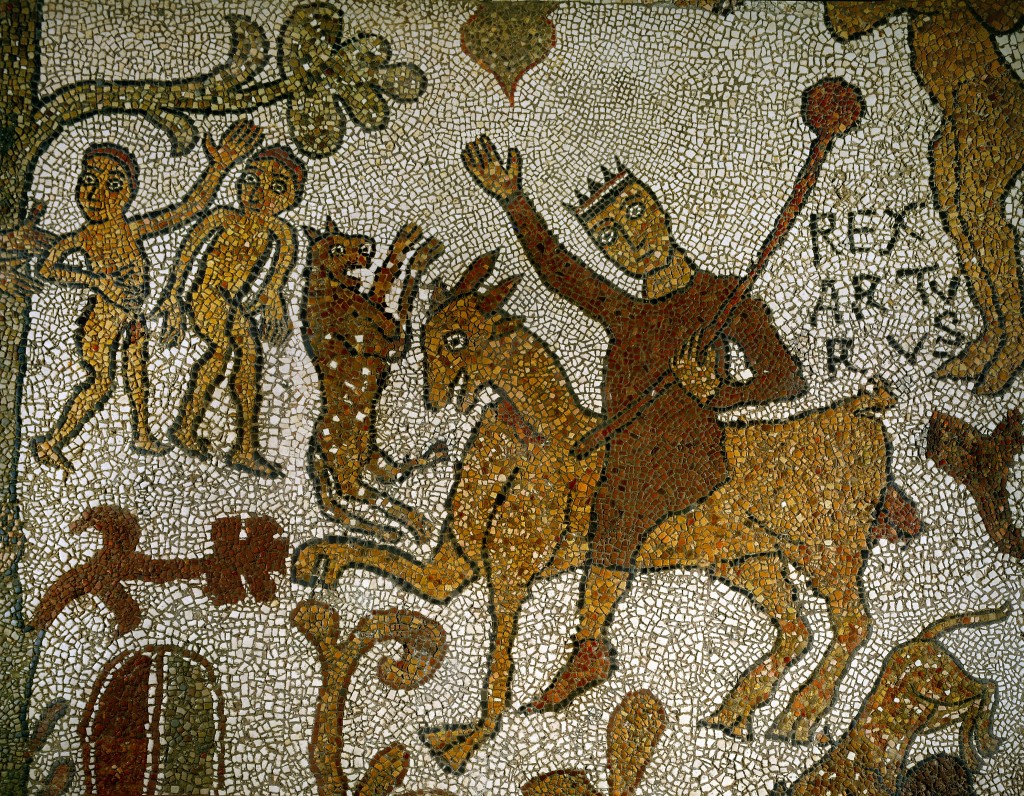By Alyssa Granacki and Joseph Williams

Detail of floor mosaic at the Otranto. Cathedral Photograph by Palickap. Available via Wikimedia.
The spectacular mosaic floor of Otranto Cathedral, completed ca. 1165, includes an image of King Arthur riding a hoofed quadruped (possibly a horse). The presence of Arthur in a scheme that includes other historical, non-biblical kings, including Alexander the Great, shows that the figure of Arthur had not only become recognizable within the southern Italian vernacular, but had even found a specific place in church iconography. This significance, however, is enigmatic. At the very least, it demonstrates the presence of Arthurian tales in Italy nearly one hundred years before French manuscripts were circulating, and suggests that Dante’s encounter with the legend was not exclusively one of a written tradition.

Detail of King Arthur. Floor mosaic at Otranto Cathedral.
Dante alludes to the Arthurian tales four times throughout his works. He recalls the “beautiful tales of King Arthur” in the De vulgari eloquentia alongside “histories of Troy and Rome” and “and many other works of history and doctrine” (trans. Botterill 1.X.2). Just as the mosaic places Arthur with historical figures, Dante, too, seems to imply Arthur’s historical veracity. Despite the presence of Arthur at the Otranto Cathedral, the Modena Archivolt, and throughout Italian art, Dante more often invokes the character of Lancelot. Dante exalts Lancelot in the Convivio as an example of man who eschews earthly pleasures in pursuit of something greater at the end of his life, namely his religious conversion (4.28, 7-8). Yet in the Comedy, the kiss between Lancelot and Guinevere is condemned through the figure of Francesca (Inf 5) and again through Beatrice (Par 16).
Selected Bibliography
Allaire, Gloria and F. Regina Psaki. Arthur of the Italians: The Arthurian Legend in Medieval Italian Literature and Culture. Cardiff: University of Wales Press, 2014.
Hoffman, Donald. “Lancelot in Italy,” in Companion to the Lancelot-Grail Cycle, ed. Carol Dover. Cambridge: DS Brewer, 2003.
“Italian Arthurian Art” in The New Arthurian Encyclopedia, ed. Norris J. Lacy. New York: Routledge, 2013.
Papio, Michael. “Lancelot” in Medieval Italy: An Encyclopedia, ed. Christopher Kleinhenz. New York: Routledge, 2004.
Whitaker, Muriel. “Early Arthurian Art,” in A History of Arthurian Scholarship, ed. Norris J. Lacy. Cambridge: DS Brewer, 2006.